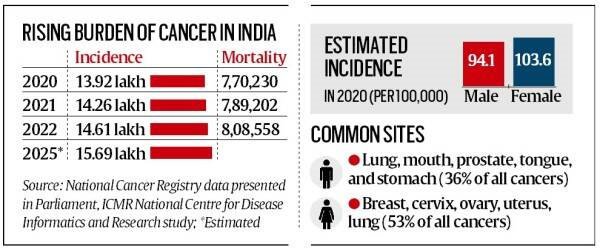Cancer in India : A status report

Context :
- Deaths due to cancer have declined by 33% in the United States since 1991, according to a report by the American Cancer Society released last week.
- This has translated into 3.8 million fewer deaths, the report said, and attributed the success to early detection, lower rates of smoking, and improvements in cancer treatment.
- This trend is yet to be reflected in India. Even with improvements in treatment, both the incidence of cancer and mortality continue to rise in the country.
Status in India :
- An estimated 14.6 lakh new cancer cases were detected in 2022, up from 14.2 lakh in 2021 and 13.9 lakh in 2020, as per data from the National Cancer Registry of the Indian Council of Medical Research (ICMR) presented in Parliament.

- Deaths due to cancer increased to an estimated 8.08 lakh in 2022 from 7.9 lakh in 2021 and 7.7 lakh in 2020.
- The incidence of all cancers is estimated to increase to 15.7 lakh by 2025, according to the data.
- One in nine Indians will develop cancer during their lifetime, according to an ICMR study using data from population-based cancer registries.
- One in 68 men will develop lung cancer and one in 29 women will develop breast cancer, according to the study.
- The incidence of cancer is higher among women — 103.6 per 100,000 in 2020 compared to 94.1 among men.
- Among men, the most common cancers were of the lung, mouth, prostate, tongue, and stomach; for women, they were breast, cervix, ovary, uterus, lung.

The unequal drop and rise of different cancers :
- The incidence of cervical cancer has dropped in India over the last 50 years from 45 to 10 per 100,000 population.
- At the same time, there is an increase in rates of breast cancer, especially in urban centres.
- Rates of cervical cancer have declined because of later marriages, fewer children, better hygiene, and vaccination.
- Also the incidence of breast cancer has gone up because of the same reasons — later age of marriage, having the first child at a later age, not breastfeeding, and a high protein diet.
- Unlike cervical cancer, which can be prevented with HPV vaccination — with vaccines becoming cheaper, the government plans a campaign soon.
- The rates of tobacco-related cancers — oral, oesophageal — cancers are also coming down.
- This is largely due to tobacco laws that have brought down smoking in public places.
Issues that still remains :
- There is no specific intervention for breast cancers other than screening because what causes it is unknown.
- Lung cancer is caused not only by smoking.
- For example, lung cancer rates are high in Arunachal Pradesh because they light fires indoors in winter.
- Also lung cancers in women in Bihar because they have spent years cooking on challahs.
- Lack of awareness among the vulnerable population.
- Lack of synergies between various departments.
Steps needed to bring down the cancer :
- Screening: Screening for the three most common types of cancer — breast, cervical, and oral — has already started through the government’s upgraded health and wellness centres.
- This, coupled with other government programmes, has meant people are reaching hospitals sooner.
- Convergence and coordination: There are several programmes of the government that are working independently and in silos.
- They need to be coordinated so that once a person is screened, they do reach a hospital.
Better screening and treatment centres, and more comprehensive linkages between screening centres and hospitals are essential to reduce cancer mortality in the country.
Syllabus : GS2 – Health


